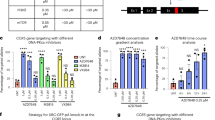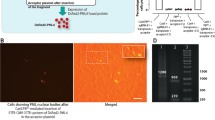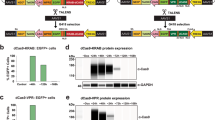Abstract
Interactions between newly integrate DNA and the host genome limit the reliability and safety of transgene integration for therapeutic cell engineering and other applications. Although targeted gene delivery has made considerable progress, the question of where to insert foreign sequences in the human genome to maximize safety and efficacy has received little attention. In this Opinion article, we discuss 'genomic safe harbours' — chromosomal locations where therapeutic transgenes can integrate and function in a predictable manner without perturbing endogenous gene activity and promoting cancer.
This is a preview of subscription content, access via your institution
Access options
Subscribe to this journal
Receive 12 print issues and online access
$209.00 per year
only $17.42 per issue
Buy this article
- Purchase on Springer Link
- Instant access to full article PDF
Prices may be subject to local taxes which are calculated during checkout


Similar content being viewed by others
References
Cartier, N. et al. Hematopoietic stem cell gene therapy with a lentiviral vector in X-linked adrenoleukodystrophy. Science 326, 818–823 (2009).
Aiuti, A. et al. Multilineage hematopoietic reconstitution without clonal selection in ADA-SCID patients treated with stem cell gene therapy. J. Clin. Invest. 117, 2233–2240 (2007).
Gaspar, H. B. et al. Hematopoietic stem cell gene therapy for adenosine deaminase-deficient severe combined immunodeficiency leads to long-term immunological recovery and metabolic correction. Sci. Transl. Med. 3, 97ra80 (2011).
Riviere, I., Dunbar, C. & Sadelain, M. Hematopoietic stem cell engineering at a crossroads. Blood 17 Nov 2011 (doi:10.1182/blood-2011-09-349993).
Martin, D. I. & Whitelaw, E. The vagaries of variegating transgenes. Bioessays 18, 919–923 (1996).
Kioussis, D. & Festenstein, R. Locus control regions: overcoming heterochromatin-induced gene inactivation in mammals. Curr. Opin. Genet. Dev. 7, 614–619 (1997).
Rivella, S. & Sadelain, M. Genetic treatment of severe hemoglobinopathies: the combat against transgene variegation and transgene silencing. Semin. Hematol. 35, 112–125 (1998).
Bestor, T. H. Gene silencing as a threat to the success of gene therapy. J. Clin. Invest. 105, 409–411 (2000).
Ellis, J. Silencing and variegation of gammaretrovirus and lentivirus vectors. Hum. Gene Ther. 16, 1241–1246 (2005).
Karpen, G. H. Position-effect variegation and the new biology of heterochromatin. Curr. Opin. Genet. Dev. 4, 281–291 (1994).
Weiler, K. S. & Wakimoto, B. T. Heterochromatin and gene expression in Drosophila. Annu. Rev. Genet. 29, 577–605 (1995).
Nusse, R., van Ooyen, A., Cox, D., Fung, Y. K. & Varmus, H. Mode of proviral activation of a putative mammary oncogene (int-1) on mouse chromosome 15. Nature 307, 131–136 (1984).
Schroder, A. R. et al. HIV-1 integration in the human genome favors active genes and local hotspots. Cell 110, 521–529 (2002).
Wu, X., Li, Y., Crise, B. & Burgess, S. M. Transcription start regions in the human genome are favored targets for MLV integration. Science 300, 1749–1751 (2003).
Mitchell, R. S. et al. Retroviral DNA integration: ASLV, HIV, and MLV show distinct target site preferences. PLoS Biol. 2, E234 (2004).
HaceinBeyAbina, S. et al. LMO2-associated clonal T cell proliferation in two patients after gene therapy for SCID-X1. Science 302, 415–419 (2003).
Ott, M. G. et al. Correction of X-linked chronic granulomatous disease by gene therapy, augmented by insertional activation of MDS1-EVI1, PRDM16 or SETBP1. Nature Med. 12, 401–409 (2006).
Stein, S. et al. Genomic instability and myelodysplasia with monosomy 7 consequent to EVI1 activation after gene therapy for chronic granulomatous disease. Nature Med. 16, 198–204 (2010).
Howe, S. J. et al. Insertional mutagenesis combined with acquired somatic mutations causes leukemogenesis following gene therapy of SCID-X1 patients. J. Clin. Invest. 118, 3143–3150 (2008).
Cavazzana-Calvo, M. et al. Transfusion independence and HMGA2 activation after gene therapy of human beta-thalassaemia. Nature 467, 318–322 (2010).
Kustikova, O. S. et al. Dose finding with retroviral vectors: correlation of retroviral vector copy numbers in single cells with gene transfer efficiency in a cell population. Blood 102, 3934–3937 (2003).
Modlich, U. et al. Leukemias following retroviral transfer of multidrug resistance 1 (MDR1) are driven by combinatorial insertional mutagenesis. Blood 105, 4235–4246 (2005).
Chang, A. H. & Sadelain, M. The genetic engineering of hematopoietic stem cells: the rise of lentiviral vectors, the conundrum of the ltr, and the promise of lineage-restricted vectors. Mol. Ther. 15, 445–456 (2007).
Gijsbers, R. et al. LEDGF hybrids efficiently retarget lentiviral integration into heterochromatin. Mol. Ther. 18, 552–560 (2010).
Modlich, U. et al. Cell-culture assays reveal the importance of retroviral vector design for insertional genotoxicity. Blood 108, 2545–2553 (2006).
Montini, E. et al. The genotoxic potential of retroviral vectors is strongly modulated by vector design and integration site selection in a mouse model of HSC gene therapy. J. Clin. Invest. 119, 964–975 (2009).
Emery, D. W. The use of chromatin insulators to improve the expression and safety of integrating gene transfer vectors. Hum. Gene Ther. 22, 761–774 (2011).
Persons, D. A. & Baum, C. Solving the problem of gamma-retroviral vectors containing long terminal repeats. Mol. Ther. 19, 229–231 (2011).
Capecchi, M. R. Gene targeting in mice: functional analysis of the mammalian genome for the twenty-first century. Nature Rev. Genet. 6, 507–512 (2005).
Moynahan, M. E. & Jasin, M. Mitotic homologous recombination maintains genomic stability and suppresses tumorigenesis. Nature Rev. Mol. Cell Biol. 11, 196–207 (2010).
Jasin, M. Genetic manipulation of genomes with rare-cutting endonucleases. Trends Genet. 12, 224–228 (1996).
Porteus, M. H. & Carroll, D. Gene targeting using zinc finger nucleases. Nature Biotechnol. 23, 967–973 (2005).
Paques, F. & Duchateau, P. Meganucleases and DNA double-strand break-induced recombination: perspectives for gene therapy. Curr. Gene Ther. 7, 49–66 (2007).
Boch, J. TALEs of genome targeting. Nature Biotechnol. 29, 135–136 (2011).
Rosenberg, N., Jolicouer, P., Coffin, J. M., Hughes, S. H. & Varmus, H. E. in Retroviruses 475–586 (Cold Spring Harbor Laboratory Press, Cold Spring Harbor, USA, 1997).
Akagi, K., Suzuki, T., Stephens, R. M., Jenkins, N. A. & Copeland, N. G. RTCGD: retroviral tagged cancer gene database. Nucleic Acids Res. 32, D523–D527 (2004).
Kim, R. et al. Genome-based identification of cancer genes by proviral tagging in mouse retrovirus-induced T-cell lymphomas. J. Virol. 77, 2056–2062 (2003).
Kohn, D. B., Sadelain, M. & Glorioso, J. C. Occurrence of leukaemia following gene therapy of X-linked SCID. Nature Rev. Cancer 3, 477–488 (2003).
HaceinBeyAbina, S. et al. Efficacy of gene therapy for X-linked severe combined immunodeficiency. N. Engl. J. Med. 363, 355–364 (2010).
Higgins, M. E., Claremont, M., Major, J. E., Sander, C. & Lash, A. E. CancerGenes: a gene selection resource for cancer genome projects. Nucleic Acids Res. 35, D721–D726 (2007).
Huret, J. L., Minor, S. L., Dorkeld, F., Dessen, P. & Bernheim, A. Atlas of genetics and cytogenetics in oncology and haematology, an interactive database. Nucleic Acids Res. 28, 349–351 (2000).
Sjoblom, T. et al. The consensus coding sequences of human breast and colorectal cancers. Science 314, 268–274 (2006).
Futreal, P. A. et al. A census of human cancer genes. Nature Rev. Cancer 4, 177–183 (2004).
The Cancer Genome Atlas Research Network. Integrated genomic analyses of ovarian carcinoma. Nature 474, 609–615 (2011).
Lombardo, A. et al. Site-specific integration and tailoring of cassette design for sustainable gene transfer. Nature Methods 8, 861–869 (2011).
Lander, E. S. et al. Initial sequencing and analysis of the human genome. Nature 409, 860–921 (2001).
Smit, A. F. Interspersed repeats and other mementos of transposable elements in mammalian genomes. Curr. Opin. Genet. Dev. 9, 657–663 (1999).
Brady, T. et al. Integration target site selection by a resurrected human endogenous retrovirus. Genes Dev. 23, 633–642 (2009).
Barr, S. D., Leipzig, J., Shinn, P., Ecker, J. R. & Bushman, F. D. Integration targeting by avian sarcoma-leukosis virus and human immunodeficiency virus in the chicken genome. J. Virol. 79, 12035–12044 (2005).
Kotin, R. M., Linden, R. M. & Berns, K. I. Characterization of a preferred site on human chromosome 19q for integration of adeno-associated virus DNA by non-homologous recombination. EMBO J. 11, 5071–5078 (1992).
Henckaerts, E. & Linden, R. M. Adeno-associated virus: a key to the human genome? Future Virol. 5, 555–574 (2010).
Schnepp, B. C., Jensen, R. L., Chen, C. L., Johnson, P. R. & Clark, K. R. Characterization of adeno-associated virus genomes isolated from human tissues. J. Virol. 79, 14793–14803 (2005).
Gao, G. et al. Adeno-associated viruses undergo substantial evolution in primates during natural infections. Proc. Natl Acad. Sci. USA 100, 6081–6086 (2003).
Drew, H. R., Lockett, L. J. & Both, G. W. Increased complexity of wild-type adeno-associated virus-chromosomal junctions as determined by analysis of unselected cellular genomes. J. Gen. Virol. 88, 1722–1732 (2007).
Huser, D. et al. Integration preferences of wildtype AAV-2 for consensus rep-binding sites at numerous loci in the human genome. PLoS Pathog 6, e1000985 (2010).
McCarty, D. M., Young, S. M., Jr. & Samulski, R. J. Integration of adeno-associated virus (AAV) and recombinant AAV vectors. Annu. Rev. Genet. 38, 819–845 (2004).
Mehrle, S., Rohde, V. & Schlehofer, J. R. Evidence of chromosomal integration of AAV DNA in human testis tissue. Virus Genes 28, 61–69 (2004).
Hernandez, Y. J. et al. Latent adeno-associated virus infection elicits humoral but not cell-mediated immune responses in a nonhuman primate model. J. Virol. 73, 8549–8558 (1999).
DeKelver, R. C. et al. Functional genomics, proteomics, and regulatory DNA analysis in isogenic settings using zinc finger nuclease-driven transgenesis into a safe harbor locus in the human genome. Genome Res. 20, 1133–1142 (2010).
Zou, J. et al. Oxidase-deficient neutrophils from X-linked chronic granulomatous disease iPS cells: functional correction by zinc finger nuclease-mediated safe harbor targeting. Blood 117, 5561–5572 (2011).
Ramachandra, C. J. et al. Efficient recombinase-mediated cassette exchange at the AAVS1 locus in human embryonic stem cells using baculoviral vectors. Nucleic Acids Res. 39, e107 (2011).
Smith, J. R. et al. Robust, persistent transgene expression in human embryonic stem cells is achieved with AAVS1-targeted integration. Stem Cells 26, 496–504 (2008).
Yang, L. et al. Human cardiovascular progenitor cells develop from a KDR+ embryonicstemcell-derived population. Nature 453, 524–528 (2008).
Hockemeyer, D. et al. Efficient targeting of expressed and silent genes in human ESCs and iPSCs using zinc-finger nucleases. Nature Biotechnol. 27, 851–857 (2009).
Henckaerts, E. et al. Site-specific integration of adeno-associated virus involves partial duplication of the target locus. Proc. Natl Acad. Sci. USA 106, 7571–7576 (2009).
Dutheil, N. et al. Characterization of the mouse adeno-associated virus AAVS1 ortholog. J. Virol. 78, 8917–8921 (2004).
Ogata, T., Kozuka, T. & Kanda, T. Identification of an insulator in AAVS1, a preferred region for integration of adeno-associated virus DNA. J. Virol. 77, 9000–9007 (2003).
Liu, R. et al. Homozygous defect in HIV-1 coreceptor accounts for resistance of some multiply-exposed individuals to HIV-1 infection. Cell 86, 367–377 (1996).
Perez, E. E. et al. Establishment of HIV-1 resistance in CD4+ T cells by genome editing using zinc-finger nucleases. Nature Biotechnol. 26, 808–816 (2008).
Rottman, J. B. et al. Cellular localization of the chemokine receptor CCR5. Correlation to cellular targets of HIV-1 infection. Am. J. Pathol. 151, 1341–1351 (1997).
Lim, J. K., Glass, W. G., McDermott, D. H. & Murphy, P. M. CCR5: no longer a “good for nothing” gene--chemokine control of West Nile virus infection. Trends Immunol. 27, 308–312 (2006).
Lombardo, A. et al. Gene editing in human stem cells using zinc finger nucleases and integrase-defective lentiviral vector delivery. Nature Biotechnol. 25, 1298–1306 (2007).
Zambrowicz, B. P. et al. Disruption of overlapping transcripts in the ROSA beta geo 26 gene trap strain leads to widespread expression of beta-galactosidase in mouse embryos and hematopoietic cells. Proc. Natl Acad. Sci. USA 94, 3789–3794 (1997).
Irion, S. et al. Identification and targeting of the ROSA26 locus in human embryonic stem cells. Nature Biotechnol. 25, 1477–1482 (2007).
Papapetrou, E. P. et al. Genomic safe harbors permit high beta-globin transgene expression in thalassemia induced pluripotent stem cells. Nature Biotechnol. 29, 73–78 (2011).
Li, Q., Peterson, K. R., Fang, X. & Stamatoyannopoulos, G. Locus control regions. Blood 100, 3077–3086 (2002).
Bejerano, G. et al. Ultraconserved elements in the human genome. Science 304, 1321–1325 (2004).
Fraser, P. Transcriptional control thrown for a loop. Curr. Opin. Genet. Dev. 16, 490–495 (2006).
Gingeras, T. R. Origin of phenotypes: genes and transcripts. Genome Res. 17, 682–690 (2007).
Ciuffi, A. et al. Methods for integration site distribution analyses in animal cell genomes. Methods (San Diego, Calif.) 47, 261–268 (2009).
Gabriel, R. et al. Comprehensive genomic access to vector integration in clinical gene therapy. Nature Med. 15, 1431–1436 (2009).
Brady, T. et al. A method to sequence and quantify DNA integration for monitoring outcome in gene therapy. Nucleic Acids Res. 39, e72 (2011).
Ogino, H., McConnell, W. B. & Grainger, R. M. High-throughput transgenesis in Xenopus using I-SceI meganuclease. Nature Protoc. 1, 1703–1710 (2006).
Cermak, T. et al. Efficient design and assembly of custom TALEN and other TAL effector-based constructs for DNA targeting. Nucleic Acids Res. 39, e82 (2011).
Papapetrou, E. P. & Sadelain, M. Reconstructing blood from induced pluripotent stem cells. F1000 Med. Rep. 2, 44 (2010).
Wang, G. P. et al. Dynamics of gene-modified progenitor cells analyzed by tracking retroviral integration sites in a human SCID-X1 gene therapy trial. Blood 115, 4356–4366 (2010).
Acknowledgements
The authors thank N. Malani, S. Roth and A. Bailey for help with the Cancer Gene database. This work was supported by US NIH grants CA059350, HL053750, DK087923, AI052845 and AI082020 and by the New York State Stem Cell Science (NYSTEM) grant N08T060.
Author information
Authors and Affiliations
Corresponding author
Ethics declarations
Competing interests
The authors declare no competing financial interests.
Glossary
- Euchromatic portion
-
A region of chromatin that has lighter packing than heterochromatin and that is generally considered to be richer in actively transcribed genes.
- Gene trapping screen
-
A high-throughput approach used to report and/or inactivate the expression of multiple individual genes across the genome by introducing a reporter gene lacking a promoter (through plasmid or retroviral gene transfer). Selection for expression of the gene requires transcription from a cellular promoter.
- Insulator elements
-
Regulatory DNA elements that create boundaries in chromatin, delineating the ranges over which neighbouring regulatory elements function. They can have enhancer-blocking activity, which prevents communication between discrete sequence elements (typically enhancers and promoters) when insulators are positioned between them, and/or barrier activity, which prevents the spread of heterochromatin.
- Intergenic transcription
-
Transcription of chromosomal DNA sequences between known genes.
- Locus control regions
-
A class of cis-acting DNA regulatory elements that confer high level, tissue-specific, site-of-integration-independent, copy number-dependent expression on linked transgenes located at ectopic chromatin sites.
- Matrix attachment regions
-
AT-rich sequences of DNA that bind to a proteinaceous nuclear scaffold called the nuclear matrix.
- Meganucleases
-
Sequence-specific endonucleases with long recognition sites (>12bp). They are naturally occurring enzymes that are harnessed as tools for targeted genome engineering by the modification of their recognition sequence.
- Proviruses
-
The duplex DNA form of the retroviral genome linked to a cellular chromosome. The provirus is produced by reverse transcription of the RNA genome and subsequent integration into the chromosomal DNA of the host cell.
- Retroviral pre-integration complexes
-
Complexes of viral and cellular proteins with retroviral DNA made by reverse transcription, which together are capable of integrating the viral DNA into a target DNA.
- Sub-telomeric regions
-
Regions adjacent to the telomeres or tips of chromosomes that are often heterochromatic.
- Transcription activator-like effector (TALE) nucleases
-
Artificial endonucleases generated by fusing a TALE DNA-binding domain to the catalytic domain of an endonuclease that introduces double-strand breaks. Similar to zinc-finger nucleases and meganucleases, TALE nucleases can also be engineered to target user-specified DNA sequences within complex genomes.
- Zinc-finger nucleases
-
A class of synthetic proteins that are generated by fusing a zinc-finger DNA-binding domain to the cleavage domain of the FokI restriction endonuclease. The DNA-binding domain can be engineered to induce double-strand breaks in desired DNA sequences, thus facilitating site-specific homologous recombination by the endogenous DNA repair machinery and targeted editing of a genomic locus (insertion, deletion and single-base substitution).
Rights and permissions
About this article
Cite this article
Sadelain, M., Papapetrou, E. & Bushman, F. Safe harbours for the integration of new DNA in the human genome. Nat Rev Cancer 12, 51–58 (2012). https://doi.org/10.1038/nrc3179
Published:
Issue Date:
DOI: https://doi.org/10.1038/nrc3179
This article is cited by
-
Precise integration of large DNA sequences in plant genomes using PrimeRoot editors
Nature Biotechnology (2024)
-
Integrating Omics and CRISPR Technology for Identification and Verification of Genomic Safe Harbor Loci in the Chicken Genome
Biological Procedures Online (2023)
-
Site-specific transgene integration in chimeric antigen receptor (CAR) T cell therapies
Biomarker Research (2023)
-
Nonmonotone invasion landscape by noise-aware control of metastasis activator levels
Nature Chemical Biology (2023)
-
A high throughput bispecific antibody discovery pipeline
Communications Biology (2023)



